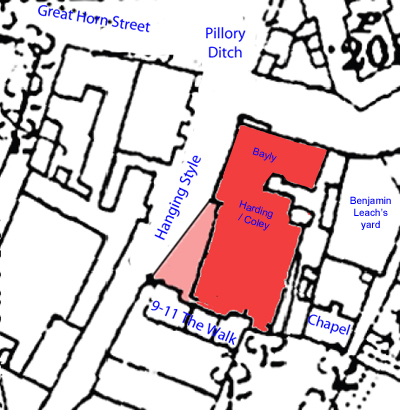
Fire, 1697
Letter from Mrs Lillie, housekeeper at Claydon House, to Sir John Verney, 16 May 1697:
I heare of a sad fier at Winslow today haith burnt about three score houses.
Bucks Quarter Sessions, Midsummer 1697:
Philip Bayly, Daniel Coley, Joseph Harding, Francis Dorsett, George Jennings, and Richard Tring, all of Winslow, to be allowed £2 each in answer to their petition for relief. They stated that, on the 16th May, "there happened a dreadfull fire in the dwelling house of the said Daniel Coley which in the space of an hower burnt to the ground the dwelling houses and outhouses of the petitioners… by which unhappy Accident the said petitioners are utterly ruined."
There were apparently no fatalities (there are no burials recorded in the parish register), and at least some of the properties were rebuilt, as shown by the Manor Court, 2 Aug 1698:
Richard Tring and Margaret his wife and Sarah Hobcroft Spinster surrendered all that slipe or parcel of land in Winslowe between the houses and yards in the occupation of Richard Tring and Henry Hughes of Winslowe, lately burned by fire and rebuilt. And liberty to sett and place a post 6 inches square at the south end of Richard Tring's house. And liberty to sett and place piles [vacerras], posts and pales to range even and straight from the said post east to the post standing on Henry's mound. With the ground on which such fencing will stand and liberty to come over the ground of Richard, Margaret and Sarah to drive his Nailes homeward to mend the piles, posts and pales at all reasonable times whenever necessary. Reserving to Richard, Margaret and Sarah liberty at all reasonable times to come in the Chewar at the south end of Richard's house to mend the house whenever necessary. To the use of Henry Hughes of Winslowe Ironmonger, who was admitted tenant. Rent 1 peppercorn, fine [blank].
 Henry Hughes must have been the landlord of one of the people affected in 1697. Daniel Cooley and Joseph Harding lived in two parts of a messuage which was divided at the 1688 court. Philip Bayly (d.1721), a collar-maker, lived in Hanging Style, i.e. The Walk. Joseph Harding's yard was west of a piece of land which was bought in 1696 from Benjamin Leach for the Baptist Meeting House. The Meeting House itself and the house which is now 9-11 The Walk pre-date the fire. It therefore seems that the area of the fire was between these buildings, as shown on the plan (right) using the 1880 Ordnance Survey map. The area shaded in darker red shows where there were buildings and yards in 1880; the lighter area (now partly occupied by Prudden House) was probably built on before the fire but not rebuilt between 1697 and 1880. None of the buildings in The Walk seems to be older than 1697. 3-5 Bell Walk (probably where the Baylys lived) are described in their listing as "formerly a single 3-bay house. C17-early C18", which would be consistent with at least a partial rebuild in 1697.
Henry Hughes must have been the landlord of one of the people affected in 1697. Daniel Cooley and Joseph Harding lived in two parts of a messuage which was divided at the 1688 court. Philip Bayly (d.1721), a collar-maker, lived in Hanging Style, i.e. The Walk. Joseph Harding's yard was west of a piece of land which was bought in 1696 from Benjamin Leach for the Baptist Meeting House. The Meeting House itself and the house which is now 9-11 The Walk pre-date the fire. It therefore seems that the area of the fire was between these buildings, as shown on the plan (right) using the 1880 Ordnance Survey map. The area shaded in darker red shows where there were buildings and yards in 1880; the lighter area (now partly occupied by Prudden House) was probably built on before the fire but not rebuilt between 1697 and 1880. None of the buildings in The Walk seems to be older than 1697. 3-5 Bell Walk (probably where the Baylys lived) are described in their listing as "formerly a single 3-bay house. C17-early C18", which would be consistent with at least a partial rebuild in 1697.
